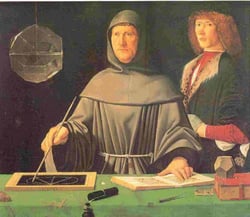 We’ve all heard the term “Renaissance man” and have come to associate good things with it. The Renaissance was a period in Italy known for its great discoveries, inventions and works of art and literature. And the best-known Renaissance man is, of course, Leonardo da Vinci, whose Mona Lisa is universally admired.
We’ve all heard the term “Renaissance man” and have come to associate good things with it. The Renaissance was a period in Italy known for its great discoveries, inventions and works of art and literature. And the best-known Renaissance man is, of course, Leonardo da Vinci, whose Mona Lisa is universally admired.
What Defines a Renaissance Man?
Thanks to Dan Brown’s Da Vinci Code, we all know that Da Vinci wasn’t just a painter but also an inventor, mathematician and writer, among other things. What separates the Renaissance man from men (and women) of other ages is the fact that they didn’t just stick to one field or occupation.
Nowadays, people are either professors or writers, accountants or artists, businessmen or web designers. They spend most of their time doing just one thing while any other interests are relegated to hobbies. However, this wasn’t the case during the Renaissance, as the case of Leonardo da Vinci shows.
Luca Pacioli’s Early Years
Another great Renaissance man who has also had a great impact on us today is Luca Pacioli. You may never have heard of Pacioli but he was actually Leonardo da Vinci’s tutor for a long time even though he came from humble origins.
According to an entry in Encyclopedia.com, Pacioli was born around 1445 in Sansepolcro, a small town in Tuscany. He came from a humble family and received an abacco education i.e., he was taught in the vernacular language rather than Latin.
At this point, Latin was the chosen language of scholars, so it might be safely concluded that Pacioli didn’t have all the privileges of the upper class. In fact, he was forced to become a self-made man and work for his living.
Growing Up: Vagabond, Monk, Tutor and Professor
At first, however, Pacioli was something of a vagabond who didn’t know what he wanted in life. He joined a Fransciscan monastery and became an apprentice to a merchant, but soon lost interest. After a while though, he became friends with Piero della Francesca, another well-known Renaissance artist, and travelled around with him, increasing his knowledge.
He went to Venice where he became a tutor to three boys and wrote his first book at the age of twenty-five. At this point, he also met the Pope and, at his behest, became a Franciscan monk.
Then he joined the University of Perugia and taught math for six years. Even at this time, he distinguished himself by emphasizing that math wasn’t just a theoretical subject but something that had a practical application.
The Invention of Double-Entry Accounting
After his stint at Perugia, wanderlust overcame Pacioli once again and he traveled around Italy for five years, until he was recalled to the university.
And this was when, at the age of 49, he wrote his seminal work, Summa de Arithmetica, Geometria, Proportioni et Proportionalita. This book contained a section on accounting which has since become famous. If you're wondering what is a bookkeeper, this book will give you the oldest and most accurate definition possible.
Pacioli was the one who came up with double-entry accounting, also known as the Venetian method. His book became widely read throughout Italy and Pacioli is today known as the “Father of Accounting.”
Later Years: Tutoring and Collaborating with Da Vinci
Because of the fame he garnered via this book, Pacioli was invited to the court of Count Lodovico Maria Sforzo to teach mathematics to a number of pupils, including Leonardo da Vinci. Pacioli continued to teach Da Vinci for nine years; his pupil also illustrated his next book, De Divina Proportione.
Towards the end of his life, Pacioli became director of the Franciscan monastery in Sansepolcro where he spent his last years.













.png)




